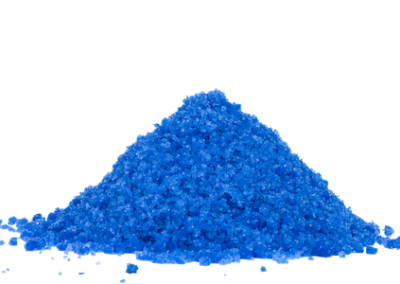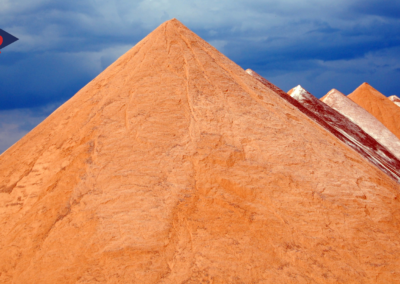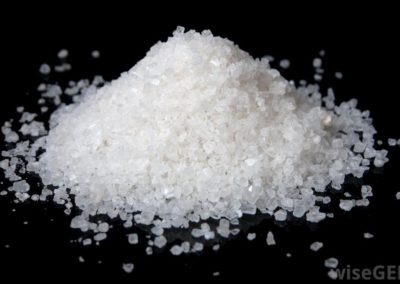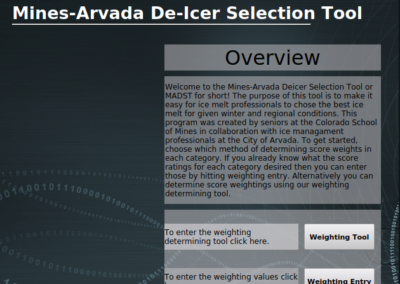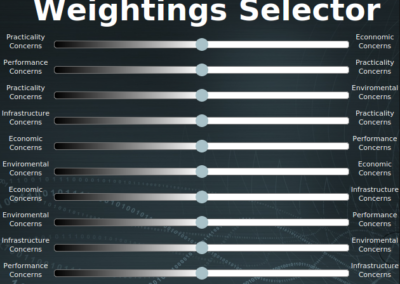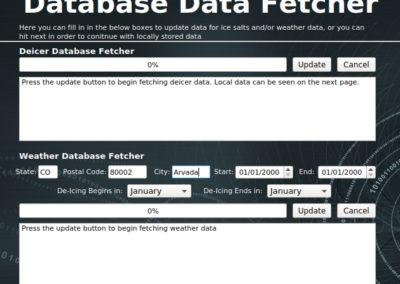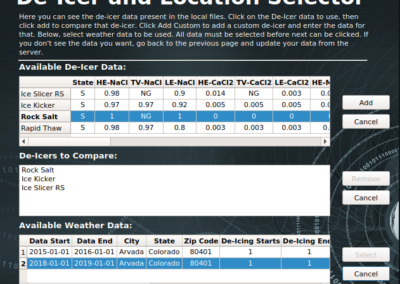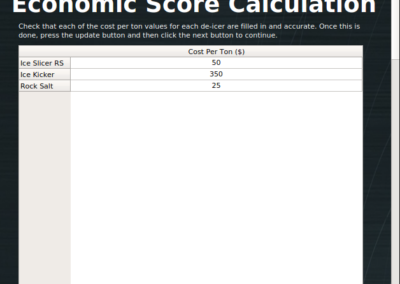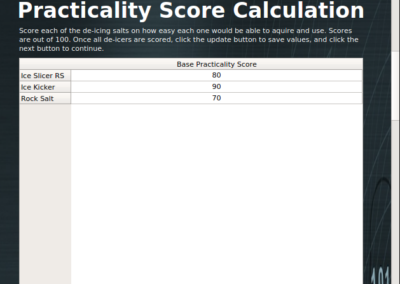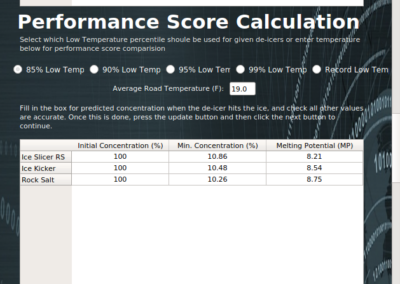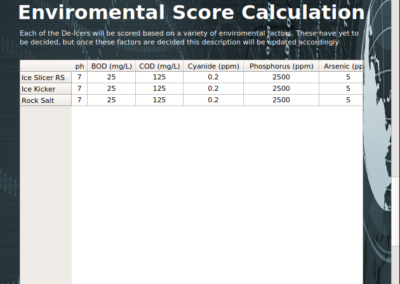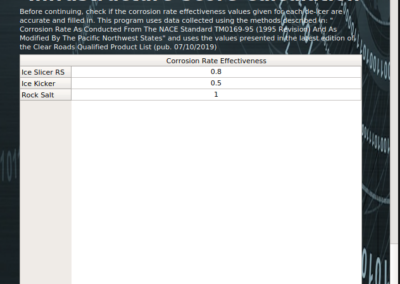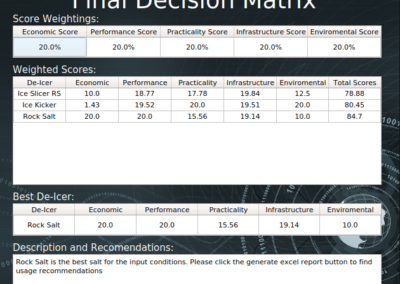Efficacy of Road Salts for Melting Snow/Ice
Overview
Project Description
The City of Arvada Public Works has tasked our Capstone Design@Mines team, Salt Solutions, with developing a system of verification regarding the efficacy of various road salts for keeping drivers safe. This system has been designed in the form of a program that takes several factors such as melting potential, environmental impact, and cost into account that are used to compare and analyze a variety of road salts. While designed specifically for Arvada’s environment, the dynamic nature of the program allows for it to be useful in a multitude of environments with the proper data adjustments. Not only does this adaptability make the program useful for other environments, it also allows for the program to transform its results as quickly as the weather changes here in Colorado.
Video Overview Courtesy of Arvada:
Who will win?
Team Members
- Cameron Hoglan
- Ali Smith
- Sully Nolan
- Scott Adams
- Nic Tsao
- Rob Scott
The Client
- City of Arvada – Dept. of Public Works
Acknowledgements
City of Arvada – Public Works Division
Project Advisor: Prof. Micheal Yoast
Technical Advisor: Prof. Lori Tunstall, Prof. Micheal Yoast
Video – Elevator Pitch
Elevator Pitch
Do you feel confident in driving in icy conditions? How do you know the streets are safe? When weather conditions hit Colorado, Coloradoans don’t stop! With the MADST De-icer selection tool, we can be sure that our choice of deicing road salt is the most effective for any given situation. Combining elements from several different factors such as the environment, cost, and overall melting potential, the best salt for any given storm becomes clear. Team Salt Solutions, with the sponsorship of the City of Arvada Snow and Ice present: MADST Deicer Selection Tool
Design Approach
Throughout the design process, Salt Solutions’ design solution underwent several iterations with various concept changes. First, the team considered two forms of ranking methodology: relative ranking and absolute ranking. After considering the functionality of both in conjunction with client input, the team determined a relative ranking methodology best fit the program’s intended applications. Second, the team discussed various methods for updating dynamic data within the program’s database. After deliberation, the team concluded that an input system which collected data from an online weather source was best as it would allow for more up-to-date information. Third, the team discussed the implications of an integrated calculation inspection tool compared to program documentation that highlights all relevant calculations. Program documentation was determined as the preferred consideration due to the documentation’s ability to provide a comprehensive understanding of relevant information without creating a busy user interface. Additionally, the actual data that would be integrated into the program also went through several iterations. For the environmental score, three tests were conducted in order to deduce what aspects to take into account: gradation testing, lab testing, and data analysis. Beyond narrowing the scope of the environmental score, the lab testing also provided verification of the salt compositions, reinforcing the accuracy of the analysis.
Furthermore, the program’s user interface and output underwent several design iterations as the team strived to create a friendly and intuitive user experience. Such design decisions were driven by the unique needs of the City of Arvada. Specifically, the program’s decision matrix was created to perform a comprehensive analysis of relevant roadway conditions, in order to determine the ideal road salt.
The software for MADST (Mines Arvada De-Icer Selection Tool) has undergone many iterations since the conception of the program. The user-interface for one, has gone from black and white buttons, having to know what buttons/commands take you to different pages. Now more streamlined, the program can be easily used by anyone who deals with snow removal, and still used by others who have general background knowledge as to how salt affects ice.
There are also many future iterations that have the ability to increase the accuracy and effectiveness of the program. The City of Arvada has expressed interest in having their own local weather stations installed. This would allow the MADST program to have more accurate weather data that the program could pull directly into its decision-making matrix. This more accurate weather data would increase the effectiveness of the program, as it would be using real time data for the area instead of using a national weather service that might not have a station very close. Another possible iteration that could be included in the performance section is the speed of melting, once the salt is applied.
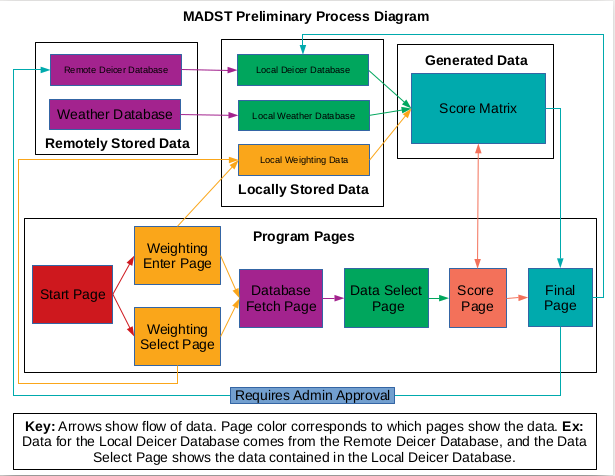
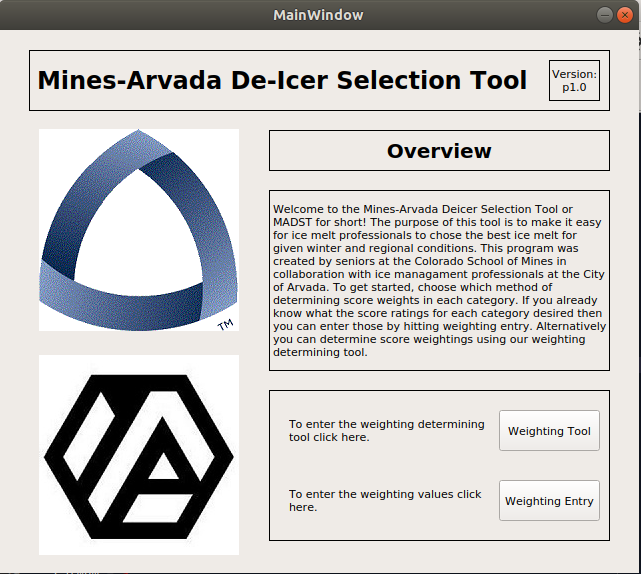
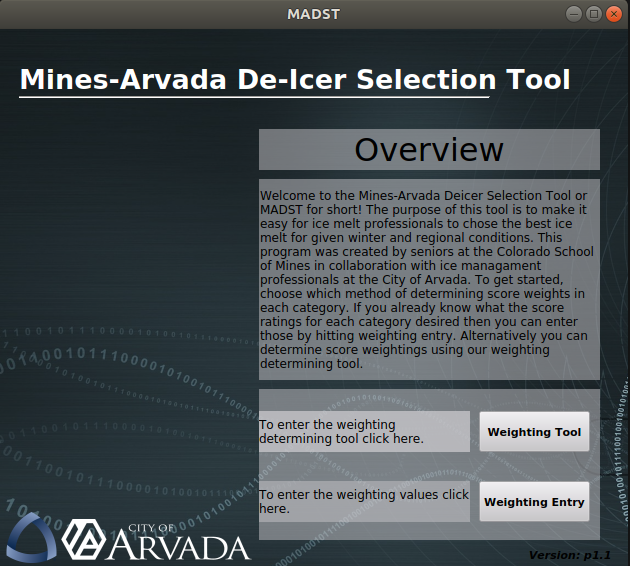
Design Solution
For this program there were three main goals: create a program that is not only user friendly but adaptable, analyze the efficacy of various road de-icers, and determine the type and quantity of de-icer that will best serve the environment & drivers at that time. The program considers five aspects of de-icers: practicality, performance, economic feasibility, environmental impact, and infrastructure degradation. Each consideration receives a weighting based on user inputs, generating a relative weighting scheme that is later used when scoring the de-icers in each category. Furthermore, the program incorporates a Database Data Fetcher (Figure 4), which integrates local weather data obtained from NOAA’s weather API, as well as relevant de-icer information. Such data allows for the accurate determination of the ideal road salt based on the winter storm at hand.
After collecting data through the Database Data Fetcher, the program then moves forward to the De-Icer and Location Selector page, as shown in Figure 5. This is where available information regarding a variety of de-icers is presented as well as the available weather data. This page allows the user to choose which data to use. For example, if the user has data from Arvada ranging from January 2013 to January 2018 and weather data from Lakewood for the same time frame, then the user can choose which weather data to use for the current analysis. This is another feature that supports the adaptability design goal as data can be implemented for regions outside of Arvada. The same can be done with de-icer data. On this page, material concentrations of each deicer can be modified by the user should they opt to not use the default values. A visual of the various user inputs for this page can be observed in Figure 6.
With the data regarding the weather selected and the deicers to compare determined, the scoring calculations can begin. Each salt is scored in each of the comparison categories (Figures 6 through 10)
Once each of the salts is scored, the program will end on the Final Decision Matrix (Figure 11). This is where the final scores are depicted and an Excel sheet detailing the reccomendations for the use of the winning deicer can be generated.
Next Steps
Over the course of the year, the City of Arvada has expressed interest in having their own local weather stations. With that, the next steps recommended for this project would be to link the weather stations to the program such that the database is constantly being updated. This would add a new level of accuracy as the program is performing analyses using real-time weather data. Additionally, the team encourages the sending of de-icer samples to Analytical Laboratories for the completion of environmental testing. Such testing would allow for the further refinement of environmental evaluation within the Mines-Arvada De-Icer Selection Tool. These suggestions work towards improving the overall accuracy of the decision matrix, allowing the City of Arvada to choose the best de-icer for each winter storm.
Meet the Team
Cameron Hoglan
 Cameron, like everyone else in this class, is a soon to be graduated senior, who is counting down the days until graduation, when he can run from Mines with a Civil Engineering degree. During his time at Mines, he has worn many hats. As a freshman and sophomore, he worked as a computer network engineering intern, as a sophomore and junior he worked teaching kids in an afterschool program, and during his junior and senior year at Mines, he has worked as an Engineering Assistant for a Petroleum Engineer. In this last job, he learned a substantial amount about programming with Python, so he designed the software for this project using the knowledge gained there.
Cameron, like everyone else in this class, is a soon to be graduated senior, who is counting down the days until graduation, when he can run from Mines with a Civil Engineering degree. During his time at Mines, he has worn many hats. As a freshman and sophomore, he worked as a computer network engineering intern, as a sophomore and junior he worked teaching kids in an afterschool program, and during his junior and senior year at Mines, he has worked as an Engineering Assistant for a Petroleum Engineer. In this last job, he learned a substantial amount about programming with Python, so he designed the software for this project using the knowledge gained there.
Ali Smith
 Alexandria is a graduating senior in Mechanical Engineering. Throughout her time at Mines, she has learned the importance of balance as she would use the week to focus on school but learn to take time on the weekends to get outdoors. The past four years have been extremely challenging, but also extremely rewarding, giving her the tools she will need as she goes into this next chapter of her life.
Alexandria is a graduating senior in Mechanical Engineering. Throughout her time at Mines, she has learned the importance of balance as she would use the week to focus on school but learn to take time on the weekends to get outdoors. The past four years have been extremely challenging, but also extremely rewarding, giving her the tools she will need as she goes into this next chapter of her life.
Rob Scott
 Rob is a graduating senior in Mechanical Engineering. He’s enjoyed his time at Mines learning valuable and practical skills for the engineering world. For this project, Rob focused on several important logistics and engineering analyses for testing of road salts. In his free time, he enjoys being creative and making music.
Rob is a graduating senior in Mechanical Engineering. He’s enjoyed his time at Mines learning valuable and practical skills for the engineering world. For this project, Rob focused on several important logistics and engineering analyses for testing of road salts. In his free time, he enjoys being creative and making music.
Scott Adams
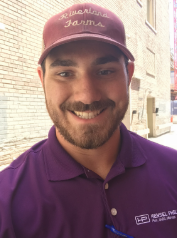 Scott is a graduating senior in Civil Engineering. He’s enjoyed being in the mountains of Colorado while attending classes and playing football at one of the best DII programs in the nation. Other activities he’s enjoyed during his time in the state include camping and fishing along trails all over the front range.
Scott is a graduating senior in Civil Engineering. He’s enjoyed being in the mountains of Colorado while attending classes and playing football at one of the best DII programs in the nation. Other activities he’s enjoyed during his time in the state include camping and fishing along trails all over the front range.
Nic Tsao
 Nicolas is a soon to be alumni of the Colorado School of Mines, graduating with a bachelor’s degree in Environmental Engineering. At Mines, he is a hard worker with a passion for protecting and preserving the environment with an emphasis on water conservation and pollution mitigation. Outside of school, he enjoys playing games that challenge his thought process and reaction time. When there is additional time on the weekends, he enjoys long hikes in the mountains and nature photography.
Nicolas is a soon to be alumni of the Colorado School of Mines, graduating with a bachelor’s degree in Environmental Engineering. At Mines, he is a hard worker with a passion for protecting and preserving the environment with an emphasis on water conservation and pollution mitigation. Outside of school, he enjoys playing games that challenge his thought process and reaction time. When there is additional time on the weekends, he enjoys long hikes in the mountains and nature photography.
Sully Nolan
 Sully is a graduating senior in Mechanical Engineering. Throughout his time at Mines, he has especially enjoyed classes focussing on Fluid Mechanics. In his free time, Sully takes advantage of the Colorado terrain and skis at local mountains.
Sully is a graduating senior in Mechanical Engineering. Throughout his time at Mines, he has especially enjoyed classes focussing on Fluid Mechanics. In his free time, Sully takes advantage of the Colorado terrain and skis at local mountains.
